Compositions
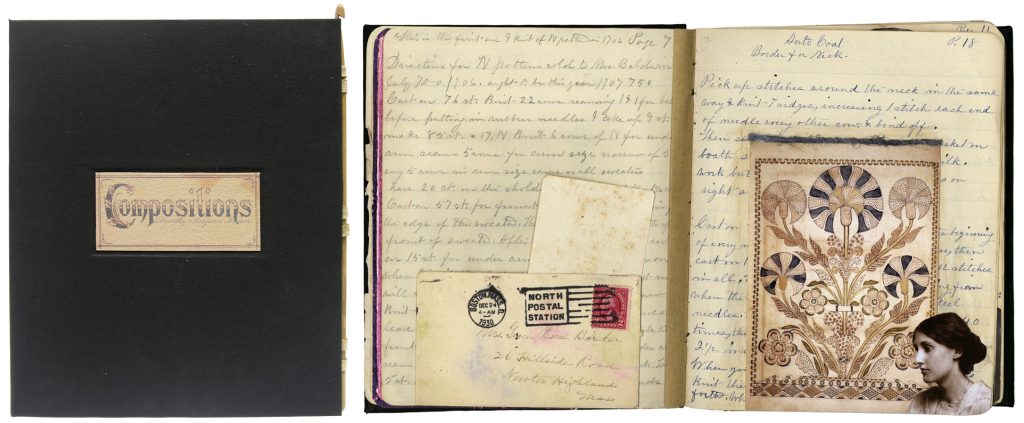
Rebound 1909 composition book containing knitting instructions, collaged with images from the first quarter of the 20th century. Housed in a custom clamshell box with vintage knitting implements. 8.5 x 7 x .875 inches, 70 pages
War Zone
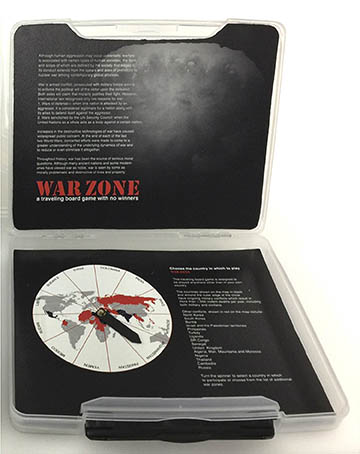
“WarZone: a traveling board game with no winner” is designed to be played anywhere other than in your own country. Instructions, game board, spinner board and game pieces are housed in a clear plastic suitcase. In the top of the suitcase, an image of the first atomic bomb blast is overlaid with a definition of war as “armed conflict, prosecuted with military forces aiming to enforce the political will of the victor upon the defeated”. It also contains information about human aggression from prehistory to the present and questions whether war is noble or morally problematic and destructive of lives and property. The Spinner Board, printed onto stiff board and contour cut to fit into in the bottom of the suitcase, allows you to choose the country in which to play and gives information on ongoing conflicts around the world. The countries shown on the map in black and around the outer edge of the circle have ongoing military conflicts that result in more than 1,000 violent deaths per year, including both military and civilians. Other conflicts are shown in red on the map. You can turn the spinner to select a country in which to participate or choose from the list of additional war zones. The Rules of Engagement state that you can place your soldier on any square of the game board and move randomly any number of spaces in any direction. You need not take turns and can remove the soldiers of any other player at will, unless you are removed first. If you are on a square with information and instructions, do as you are told. The Game Board resembles a checkerboard with squares which give instructions such as “no weapons found: look again”, “tour of duty extended: start over” and “peace negotiations begun: pray for success”. The red and black checker-like pieces are “us” and “them”. The game never ends, but may move to a different place of engagement. There are no winners, only losers. The WarZone game boards and suitcase were printed at Roland DGA on the LEF-300. a flatbed printer with white and gloss inks. It is an edition of ten in a suitcase 10 3/8” x 12 7/8” x 1 ½”.
Mending

“Mending” is a 6″ x 6″ woven album structure with 62 mixed media/ collaged pages. The cover is paper over board. Text, interspersed throughout the book, reads: a person a relationship in need of repair a rift a break a tear damaged goods how to put it right mend one’s ways to make amends sort it out patch it up stitch it together fix it working back and forth across the rift darning with resolve mending
Cape Cod
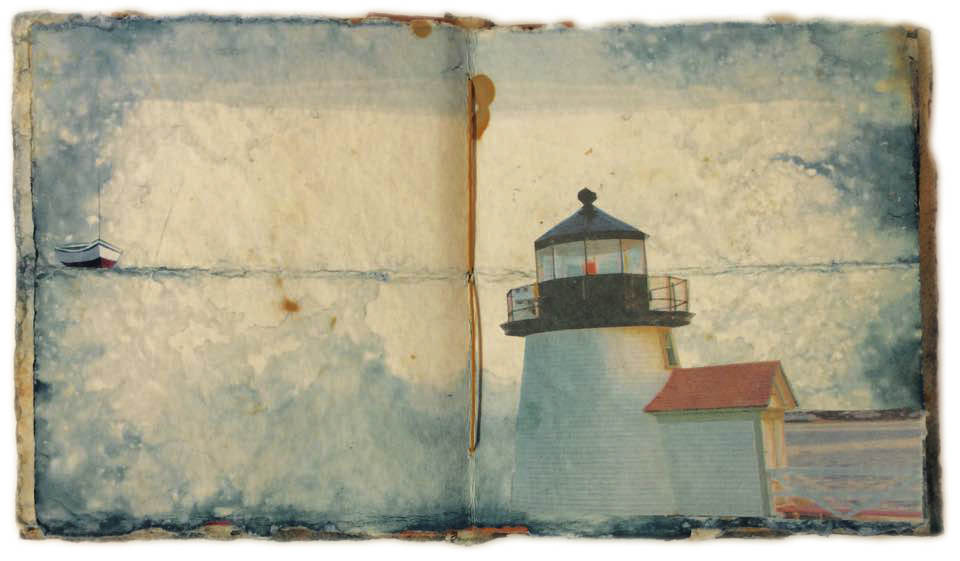
Cape Cod used paper stained with rust and indigo dye for the pages and cover. Rust colored spacers allowed for incorporating found treasures. Each double page spread, with its spacer, was sewn to the spine with a modified longstitch. An enamel pin, with a map of the area, was affixed to the cover. A horizontal dye line, across the middle of each page, suggested landscapes and seascapes for the collaged images of boats, houses and lighthouses. The journal is 6″ x 5″ x .75″ with 28 pages.
Afloat

This travel journal, completed in the Alban Hills, south of Rome, uses costume plates and a fragile map from “Caesar’s Commentaries on the Gallic War” published in 1888. The plates were collaged over mono prints which I textured to resemble the stones of Roman construction. The 22 pages, 7.75” x 5.75” x .75”, have a drum leaf binding with a replica Roman coin on the cover. The handwritten text, a quote from Shakespear’s play “Julius Caesar”, seemed appropriate since in many ways we now seem to be “afloat” — the title of the book. There is a tide in the affairs of men, which taken at the flood, leads on to fortune. Omitted, all the voyage of their life is bound in shallows and in miseries. On such a full sea are we now afloat. William Shakespeare “Julius Caesar” Act IV, Scene III
Concordat
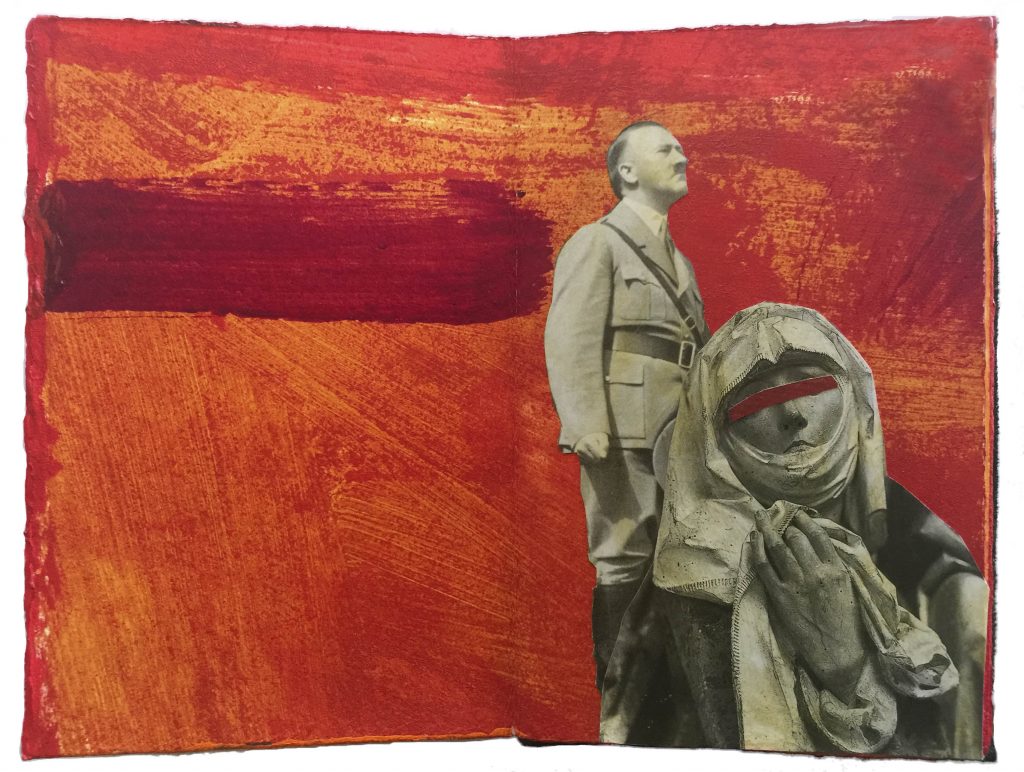
A Concordat is an agreement or treaty, especially one between the Vatican and a secular government relating to matters of mutual interest. The Reichskonkordat was a controversial treaty negotiated between the Vatican and the newly formed Nazi government. It was signed on July 20, 1933 by Cardinal Eugenio Pacelli, the Vatican Secretary of State, who later became Pope Pius XII. The Concordat effectively removed the German Catholic Church from any opposition to Hitler and gave moral legitimacy to the Nazi regime. By offering recognition from a foreign state it enabled Hitler to come to power. For the Church, it seemed to promise that it could carry out its spiritual mission, however violations of the treaty by the Nazi regime began almost immediately. Some have viewed the Concordat as a manifestation of the Pope’s preference for dictatorships over democracies and disregard for German Jews. The Vatican insisted, however, that they approved the agreement simply to protect the church. The concordat remains in effect to this day. ______________________________ Concordat, 5.5” x 3.75” x .75”, 26 painted, mono printed and collaged pages with mica overlays. Drum leaf binding with leather cover (cut from vintage jacket). Images of wood and stone by 16th century Würzburg sculptor Tilman Riemenschneider are contrasted with photographs from the exhibition, “Fascination and Terror” at the Nuremberg Documentation Center. The title uses the Gothic font Maximilian Zierbuchstaben by Dieter Steffmann. For additional documentation gathered from the Vatican archives see: Cornwell, John. “Hitler’s Pope: The Secret History of Pius XII”, Viking Press, NYC, 1999
Sisi: Empress of Austria
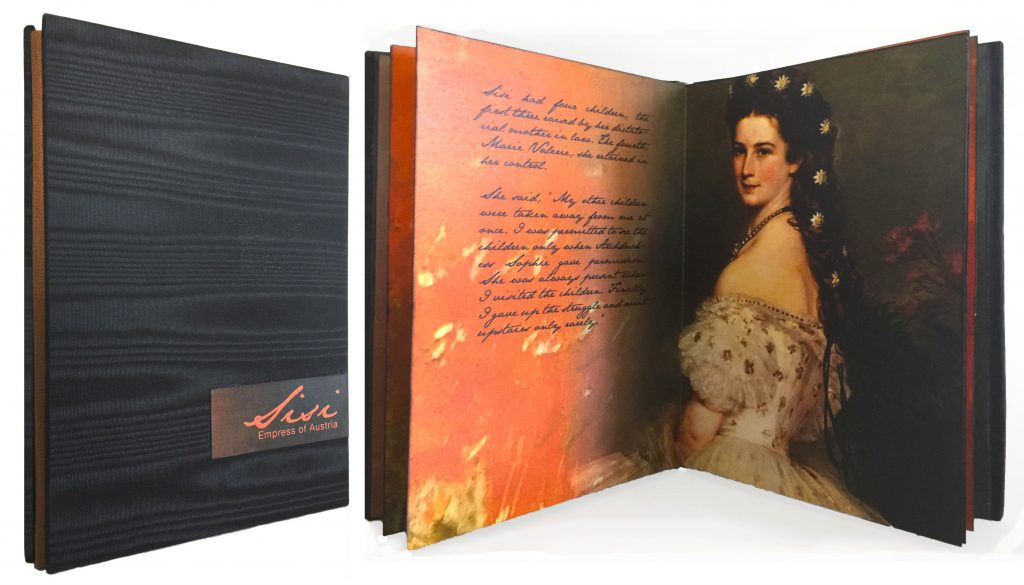
Sisi was born in Munich in 1837. At the age of 15 was married to her cousin the Hapsburg Emperor Franz Joseph. Although the Emperor was very much in love with Sisi, she was stifled by the protocol of the court and wrote in her diary, “I have awakened in a dungeon, with chains on my hands.” Later in life she added, “Marriage is an absurd arrangement. One is sold as a fifteen-year-old child and makes a vow one does not understand and then regrets for thirty years or more, and which one can never undo again.” Sisi was an especially beautiful woman, but had health issues that were attributed to tuberculosis but may have been caused by syphilis, presumably contracted from her husband. She was obsessed with her image and exercise routine. At 5’ 8”, she fasted to maintain her 110 lbs and 16” waist, had a gym installed in the palace and was extreme with her beauty products and routines. Her hair cascaded to the floor and required several hours a day to style. Sisi had four children, the first three raised by her dictatorial mother in law. The fourth, Marie Valerie, she retained in her control. She said, “My other children were taken away from me at once. I was permitted to see the children only when Archduchess Sophie gave permission. She was always present when I visited the children. Finally I gave up the struggle and went upstairs only rarely.” Fluent in Hungarian, Greek, English and French, Sisi was an unhappy woman and a restless, obsessive traveler, visiting Madeira, Morocco, Algeria, Malta, Egypt and Turkey and establishing homes in Corfu, Madeira and Venice. In a poem she wrote: “I wander lonely in this world, Delight and life long time averted, No confidant to share my inner self, A matching soul never revealed.” As she aged she said, “Ah, the horror of growing old, to feel the hand of Time laid upon one’s body, to watch the skin wrinkling, to awake and fear the morning light, and to know that one is no longer desirable! Life without beauty would be worthless to me.” She carried a hypodermic for cocaine in her travel medicine case. During one of Sisi’s illnesses, her daughter, Valerie said, “Much worse than the ailment is Mama’s indescribable despair and hopelessness. She says that it is a torment to be alive, and she indicates that she wants to kill herself.” In 1989, her son and heir to the throne, Rudolf shot his young mistress then several hours later put a bullet through his own brain at the family hunting lodge, Mayerling. After the suicide, Sisi only wore black and her spa-to-spa drifting intensified, as everyone around her fretted about her dark depressive spells. At age 61, on a street in Geneva, Sisi was stabbed by an anarchist. No one realized the extent of the injury and she subsequently died. Hearing the news of her death, her husband whispered, “No one knows how much we are loved” and adds, “Nothing will be spared me on this earth” Sisi, 7.25” x 5.25” x .25”, 10 pages, drum leaf binding with watered silk over board cover. Edition of 4
Apache

Begun on a trip to Arizona, this small book explores our appalling treatment of Native Americans. Vintage photos of Apache Indians are collaged onto small eco printed tags which are placed into a pocket accordion, designed to fit into a well-worn leather pouch. The colophon describes the subjugation of the Apache tribes as they fought to defend their homelands in the Southwest. Prospectors and settlers, supported by the might of the United States government have gained their land, natural resources and wealth while the Apaches have lost their lifestyle and their culture, religion and ceremonies have fallen into decline. 5.5″ x 3.75″ x 1.75″ closed and 5.5″ x 28″ open with 10 inserts printed back and front.
Family Portraits
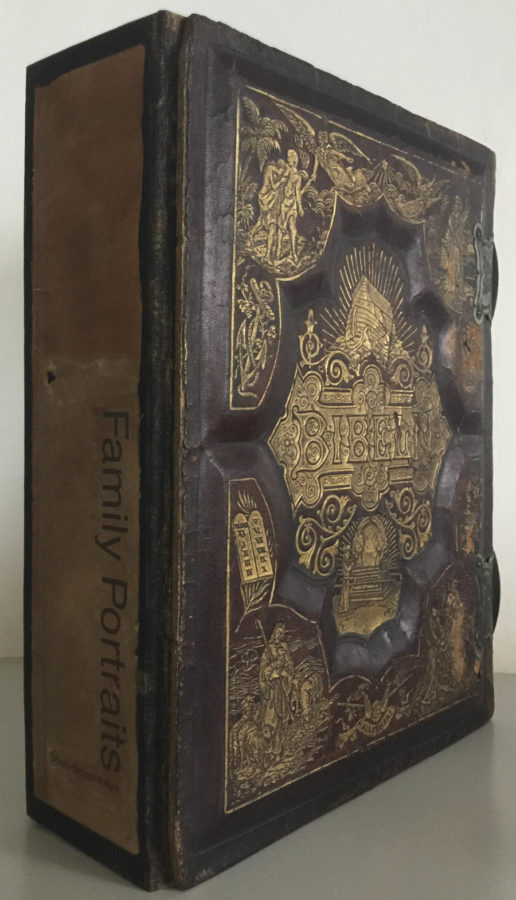
“Family Portraits”, made from the cover of a vintage leather bible, is designed to be viewed standing. It is 12.5″ x 9.5″ x 3.75″ with a spine the width of the metal closures. Since the pages were designed to hold “Family Portraits”, I chose engravings picturing women of the bible by Gustave Dore. The text accompanying the images reads: Eve and Adam “Adam named his wife Eve, because she would become the mother of all the living.” Genesis 3:20 Delilah and Sampson “If my head were shaved, my strength would leave me, and I would become as weak as any other man.” Judges 16:17 Judith “This is the head of Holofernes … The Lord has struck him down by the hand of a woman!” Judith 13:15 Mary Magdalene “Her sins, which are many, are forgiven; for she loved much.” Luke 7:47 The Virgins of Jabesh-Gilead The Benjamites found “four hundred young women who had never slept with a man, and they took them.” Judges 21:12 A vintage wood and metal box holds the book in a velvet cradle.
Casurina

Casuarina, also known as Australian pine, is an invasive species in South Florida and the Everglades. Both the leather cover and the pages of this book are eco-printed with casuarina and other botanicals. “Casuarina” is 7.75″ x 6″, a double accordion with 14 eco printed pages. The text reads: Native to Australia, Southeast Asia and the south Pacific islands, Casuarina is an evergreen tree with long, grayish-green branchlets resembling pine needles. Originally planted in Florida in the late 1800’s as a windbreak and for shade, its seeds are widely spread by birds. Casuarina is an extremely aggressive and densely rooted species that smothers its struggling competitors under a heavy blanket of needle-like litter. It displaces sand-binding native dune and beach vegetation, encouraging coastal erosion, changing soil chemistry, degrading wildlife habitat and making nesting difficult for sea turtles and other reptiles that dig cavities in which to lay their eggs. The Plant Conservation Alliance names this species as an Alien Invader. It is listed as a Category I invasive exotic species by the Florida Exotic Pest Plant Council, “invading and disrupting native plant communities in Florida”. Possession, collection, transportation, cultivation and importation of Australian pine are prohibited by the Florida Department of Environmental Protection.

